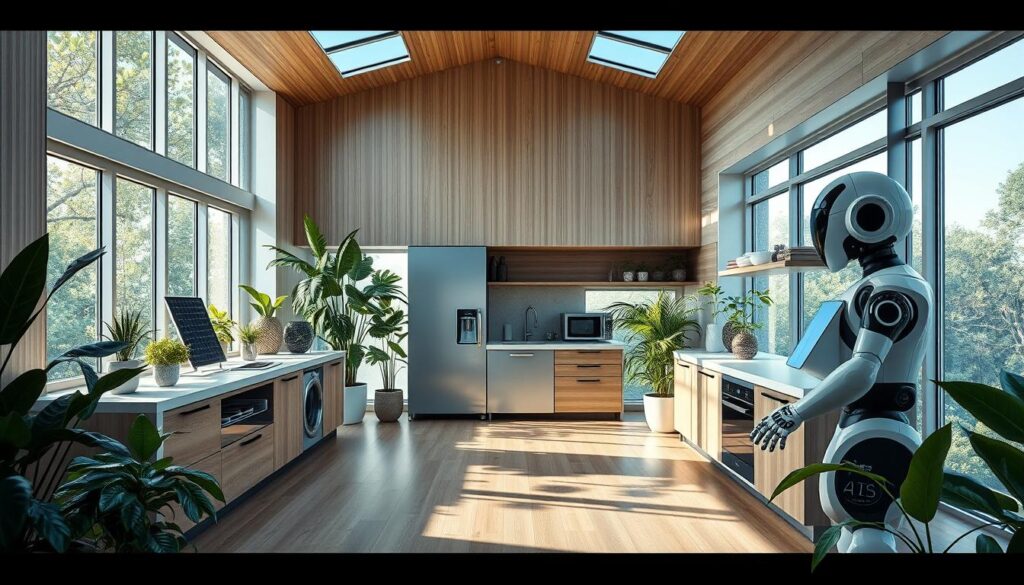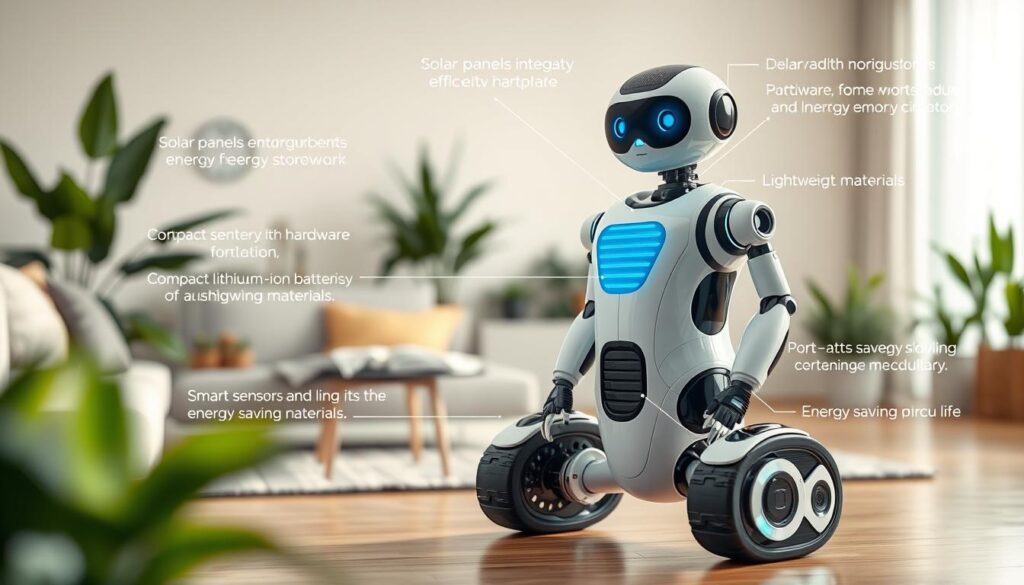Home robots and smart home solutions are becoming more popular. Engineers are working hard to make these robots use less power. They use smart designs, energy-saving parts, and advanced systems to improve their robots’ energy use.
This way, they keep the robots working well and efficient. Their goal is to make smart home robots more common and affordable. This will help make homes more sustainable and cost-effective.
Improving energy use in home robots is a big challenge. It involves hardware, software, and control strategies. Engineers pick the right robot types, designs, and materials to cut down on power use.
They also use smart motion planning and energy-saving modes. As technology advances, we can expect even better energy efficiency in home robots. Trends like dynamic power management and new mechanical processes will play a big role in this.
Introduction to Energy Optimization in Home Robotics
The rise in home robot adoption has led to energy concerns. With more electronics and smart systems in homes, their power use is a big issue. Engineers are working hard to make these robots more energy-efficient. This is to help the environment and make these technologies more common in homes.
Reducing power use is key for home robotics to grow. It’s important for making homes smarter and easier to live in.
Overview of Home Robot Adoption and Energy Concerns
The home robot adoption market has grown a lot lately. More families are using robots for help around the house. But, this growth has also highlighted the need to cut down on their energy use.
As these robots get more advanced and use more energy, they’re affecting how much power homes use. This is a big worry for many.
Importance of Energy Efficiency in Home Robot Development
Engineers and researchers are now focusing on making home robots use less energy. They’re working on better hardware and software to do this. Their goal is to lessen the robots’ environmental impact and make them more popular.
Creating energy-efficient home robots is vital for the growth of the robotics industry in homes. It’s about making these robots sustainable and useful for more families.

To make home robots work well for the long term, we need to tackle energy issues. Designing them to use less power is crucial. As more people want these smart helpers, finding ways to make them energy-efficient is a top priority for developers.
Hardware Strategies for Energy-Efficient Home Robots
As home robots become more popular, engineers are working on making them use less energy. They focus on picking the right robot types and using lightweight materials for components.
Selecting Optimal Robot Types and Configurations
The type and setup of a robot greatly affect how much energy it uses. For example, parallel robots are better for moving horizontally than traditional serial robots. This is because they need less power and torque, saving a lot of energy.
Lightweight Materials and Component Redesign
Using lighter materials in robots can also save energy. Materials like carbon fiber-reinforced polymers make robots easier to move. This not only saves energy but also makes the robot more agile and quick.
| Metric | Value |
|---|---|
| Total Intended Award Amount | $1,215,305.00 |
| Total Awarded Amount to Date | $1,215,305.00 |
| Funds Obligated to Date FY 2024 | $1,215,305.00 |
The DOE’s Science Undergraduate Laboratory Internship (SULI) program helps students work on robotics at Argonne National Laboratory. It aims to use new technologies like augmented reality and machine learning in robots. Students are working on a system to improve manufacturing.

Computer simulations are being used to make manufacturing better. This includes tasks like cutting and welding that need precision. Soft robotics, which uses flexible materials, is also being explored for safety and efficiency.
Augmented reality is being used to help humans and robots work together better in manufacturing. Machine learning and 3D sensors are being used with augmented reality to make processes more efficient. Students are testing how well augmented reality works with real actions using 3D sensors and touch devices.
The SULI program is supported by DOE’s Office of Science. The work on robots for nuclear facilities is funded by DOE’s Environmental Management Technology Development Office.
Home Robot Development: Software and Control Approaches
Developing energy-efficient home robot software and control methods is key to saving power. Motion planning algorithms are a big part of this. They make the robot’s movements more efficient, cutting down on energy use.
Engineers use software that reduces power by cutting down on unnecessary movements. This software works well with the robot’s design. Together, they make home robots more energy-efficient.
Motion Planning for Reduced Power Consumption
Motion planning algorithms are crucial for saving power in home robots. They figure out the best paths and movements for the robot. This helps avoid using too much energy and keeps the robot moving smoothly.
- Trajectory optimization techniques analyze factors like robot dynamics, obstacle avoidance, and energy consumption to plan the most efficient movements.
- Intelligent task sequencing and scheduling can reduce unnecessary robot activity, limiting power-hungry accelerations and decelerations.
- Sensor-based feedback loops enable real-time adjustments to robot motion, adapting to environmental changes and minimizing energy waste.
By combining these software strategies with the right hardware, engineers can make home robots that are both efficient and effective. These robots help homeowners in smart and cost-saving ways.
| Key Software Strategies for Energy-Efficient Home Robots | Description |
|---|---|
| Motion Planning Algorithms | Optimize trajectories and movements to reduce energy consumption |
| Trajectory Optimization Techniques | Analyze robot dynamics, obstacle avoidance, and energy use to plan efficient motions |
| Intelligent Task Sequencing and Scheduling | Reduce unnecessary robot activity and power-hungry accelerations/decelerations |
| Sensor-based Feedback Loops | Enable real-time adjustments to robot motion, adapting to environmental changes |
Emerging Trends in Home Robot Energy Optimization
The home robotics industry is seeing exciting changes to make robots more energy-efficient. One big trend is dynamic power modes. Robots can now change how much power they use based on how they’re being used. This smart way of managing power helps save money and is better for the environment.
Another trend is smart energy monitoring. Thanks to new IoT sensors, home robots can track their power use very closely. This helps users and makers find ways to use less energy and save more.
Engineers are also working on novel mechanical processes to make robots use less energy. For example, using static electricity to grasp things can cut down on the need for power. These new ideas in power management and design will keep making home robots more efficient.
By following these trends, the home robotics field is getting ready for even more dynamic power modes, smart energy monitoring, and novel mechanical processes. As people want more smart, green, and affordable robots, these advancements will be key. They will help shape the future of home robots.
Conclusion
Engineers have made big steps in making home robots use less energy. They use special hardware, software, and control strategies. This helps home robots use less power.
They pick robots that use less energy, use light materials, and plan movements smartly. New ideas like dynamic power modes and smart energy monitoring help even more. These ideas make home robots more energy-efficient.
As more people start using home robots, making them energy-efficient is key. This ensures they are sustainable and widely accepted. The focus on eco-friendly and cost-effective robots helps them fit well in homes.
This work is setting the stage for a new era of home robotics. Energy efficiency is now a big deal. It’s making these smart helpers more sustainable and accessible for everyone.

